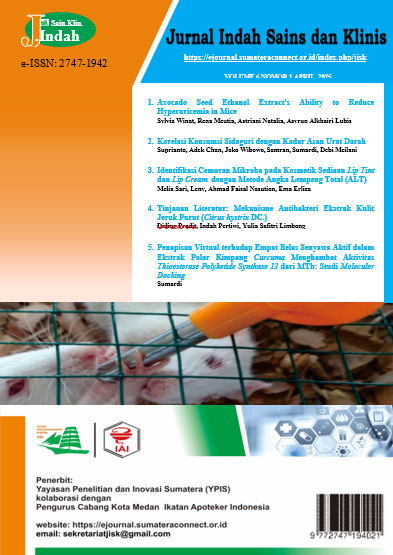Korelasi Konsumsi Sidaguri dengan Kadar Asan Urat Darah
DOI:
https://doi.org/10.52622/jisk.v6i1.02Keywords:
Sidaguri capsules, uric acid, hyperuricemiaAbstract
Background: Hyperuricemia as an indicator of increased blood uric acid. The prevalence rate in Indonesia is not recorded with certainty. However, the prevalence of gout reached 655,745 people out of 238,452,952 people in Indonesia, ranking first in Southeast Asia. Sidaguri flavonoids have inhibitory power against Xanthine Oxidase so that they can reduce uric acid. Objective: The study was aimed at detecting the effect and correlation of Sidaguri capsule consumption (Sida rhombifolia L) on reducing uric acid in patients. Method: The study was conducted Pretest and Posttest on 22 patients with hyperuricemia with the Easy Touch GCU Instrument. Results: The results showed that the average uric acid level before the intervention was 8.37 mg/dL and after the intervention was 6.57 mg/dL. Conclusion: Sidaguri capsules have an effect on reducing uric acid levels in patients
Downloads
References
M. Yulian, “Potensi Biodiversitas Indonesia sebagai Inhibitor Xanthin Oksidase dan Antigout,” Lantanida J., vol. 1, no. 1, 2014.
Ilkafah, “Daun Kersen (Muntingia Calabura L.) sebagai Alternatif Terapi pada Penderita Gout Artritis,” Pharm. Med. J., vol. 1, no. 1, 2018.
M. Darussalam et al., “Peran Air Rebusan Daun Salam (Syzgium Polyanthum) dalam Menurunkan Kadar Asam Urat,” Media Ilmu Kesehat., vol. 5, no. 2, pp. 83–91, 2016.
A. Amatus, Y. Ismanto, G. Masi, P. Studi, I. Keperawatan, and F. Kedokteran, “Pengaruh Air Rebusan Daun Kemangi terhadap Kadar Asam Urat Darah pada Penderita Hiperurisemia Di Wilayah Kerja Puskesmas Wolaang,” ejournal Keperawatan (e-Kp), vol. 4, no. 1, 2016.
V. F. M. Kussoy, R. Kundre, and F. Wowiling, “Kebiasaan Makan Makanan Tinggi Purin dengan Kadar Asam Urat di Puskesmas,” J. Keperawatan, vol. 7, no. 2, pp. 1–7, 2019, doi: 10.35790/jkp.v7i2.27476.
C. Jenkins, J. H. Hwang, J. B. Kopp, C. A. Winkler, and S. K. Cho, “Review of Urate-Lowering Therapeutics: From the Past to the Future,” Front. Pharmacol., vol. 13, no. August, pp. 1–13, 2022, doi: 10.3389/fphar.2022.925219.
J. Miner et al., “Lesinurad, A Novel, Oral Compound for Gout, Acts to Decrease Serum Uric Acid Through Inhibition of Urate Transporters in The Kidney,” Arthritis Res. Ther., vol. 18, no. 1, pp. 1–10, 2016, doi: 10.1186/s13075-016-1107-x.
M. Tanumihardja, N. Natsir, and I. K. Mattulada, “Aktivitas Antibakteri Ekstrak Terstandar Akar Sidaguri (S . rhombifolia) terhadap E. faecalis dan Actinomyces spp,” Dentofasial, vol. 12, no. 2, pp. 90–94, 2013.
A. A. D. A. Saputri, J. Amin, and Azizahwati, “Pengaruh Pemberian Kombinasi Ekstrak Air Akar Kucing (Acalypha indica Linn) dengan Ekstrak Etanol 70% Rimpang Jahe Merah (Zingiber officinale Rosc) terhadap Penurunan Kadar Asam Urat Tikus Putih,” Maj. Ilmu Kefarmasian, vol. 8, no. 3, pp. 141–153, 2011.
Ida Ayu Pradnyaswari and Ni Made Pitri Susanti, “Pengaruh Rebusan Seledri untuk Penurunan Kadar Purin Penderita Gout,” Pros. Work. dan Semin. Nas. Farm., vol. 2, pp. 77–87, 2023, doi: 10.24843/wsnf.2022.v02.p06.
F. R. Haryadi, “Effectiveness of Gout Therapy with Polyherbal Extract of Shallot (Allium ascalonicum L.) and Red Ginger (Zingiber officinale var rubrum) in Hyperuricemia Mice,” J. Sain Vet., vol. 38, no. 2, p. 135, 2020, doi: 10.22146/jsv.51360.
E. S. Suryagustina, Prinawatie, “Efektifitas Rebusan Daun Salam terhadap Penurunan Kadar Asam Urat pada Lansia,” Din. Kesehat. J. Kebidanan dan Keperawatan, vol. 13, no. 1, pp. 22–34, 2022, doi: 10.33859/dksm.v13i1.830.
R. Madyastuti, Ietje wientarsih, Setyo Widodo, Erni H Purwaningsih, and Eva Harlina, “Aktivitas Diuretik dan Analisa Mineral Urin Perlakuan Ekstrak Tanaman Kumis Kucing (Orthosiphon Stamineus Benth) pada Tikus Jantan,” Acta Vet. Indones., vol. 8, no. 2, pp. 16–23, 2020, doi: 10.29244/avi.8.2.16-23.
A. Fariz, M. A. Sholihin, R. Fauzi, and M. I. Rizki, “Review: Tanaman Obat yang Berefek Sebagai Antigout,” J. Pharmascience, vol. 5, no. 1, pp. 22–31, 2018, doi: 10.20527/jps.v5i1.5782.
K. Nur and S. A. Sumiwi, “Aktivitas Berbagai Tanaman sebagai Antihiperurisemia,” Farmaka, vol. 17, no. 1, pp. 33–49, 2020.
Y. B. C. Simarmata, A. Saragih, and H. Duncan, “Efek Hipourikemia Ekstrak Daun Sidaguri ( Sida Rhombifolia L ) pada Mencit Jantan Hipouricemia,” J. Pharm. Pharmacol., vol. 1, no. 1, pp. 21–28, 2012.
L. Lingga, Bebas Penyakit Asam Urat Tanpa Obat. AgroMedia, 2012.
P. P. Ditya Yankusuma S, “Pengaruh Rebusan Daun Salam terhadap Penurunan Kadar Asam Urat di Desa Malanggaten Kecamatan Kebakkramat Kabupaten Karanganyar,” Kosala, vol. 4, no. 1, pp. 90–96, 2016.
J. Soeroso, S. PD-KR, and H. Algristian, Asam urat. Penebar PLUS+, 2011.
Nurhayati, “Hubungan Pola Makan dengan Terjadinya Penyakit Gout (Asam Urat) di Desa Limran Kelurahan Pantoloan Boya Kecamatan Taweli,” J. Kesmas, vol. 7, no. 6, 2018.
S. C. Syafrullah, “Indonesian Sidaguri (Sida rhombifolia L .) As Antigout and Inhibition Kinetics of Flavonoids,” J Major., vol. 4, no. 1, pp. 81–85, 2015.
Downloads
Published
Issue
Section
License
Copyright (c) 2025 Jurnal Indah Sains dan Klinis

This work is licensed under a Creative Commons Attribution-NonCommercial-ShareAlike 4.0 International License.









 This work is licensed under a
This work is licensed under a 
